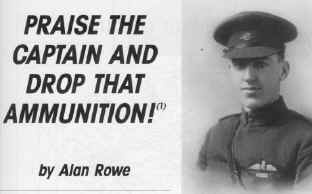 |
|
|||
|
|
||||
| AIR SUPPORT in WW1 |
| For a full account of the
Australian Flying Corps go to the
AFC section. There you will find all the aircraft, all the squadrons
and the men who made history. This page deals only with the activities
of the AFC when it was acting in close support of the infantry.
The AFC spent thousands of hours taking photos of enemy positions, they dropped thousands of bombs and performed thousands of strafing raids on enemy trenches as well as getting into dog-fights with the enemy fighters and shooting down his bombers and observation balloons. Although there were many occasions were air support was obtained two stand out as the highlights of co-operation between soldier and airman. The details are below. |
|
Supply Dropping IMPROMPTU
|
|
Supply Dropping PLANNED |

Capt. Lawrence J Wackett DFC Nov 1918 |
At 5.45am an RE8 flown by Lt G Newton with Lt A Renolds as his observer lifted off from the airfield of 3 Sqn AFC at Villers Bocage for a 10 minute flight to the battle front near the German held village of Hamel. |
| It
was the first of 13 RE8 machines that would continually return to that
area throughout the day, contributing to the success of the ground
offensive- and also making aviation history.
Visibility in the air was reported to be fair with some cloud at the 2000 foot level. At about 6.00am Newton pulled the wooden toggle of his Bowden cable operated bomb release but instead of the usual 20lb Cooper bombs falling away, two heavy wooden crates attached to a 14ft diameter parachute floated gently down to earth. Each of those boxes weighed approximately 100lbs and contained four 250 round belts of ammunition for a Vickers machine gun. This was the first ever recorded supply of ammunition by parachute to troops in battle. It was an Australian organised operation, carried out by 3 Sqn AFC with some practical assistance from RAF. Extract from a Cross & Cockade article. |
